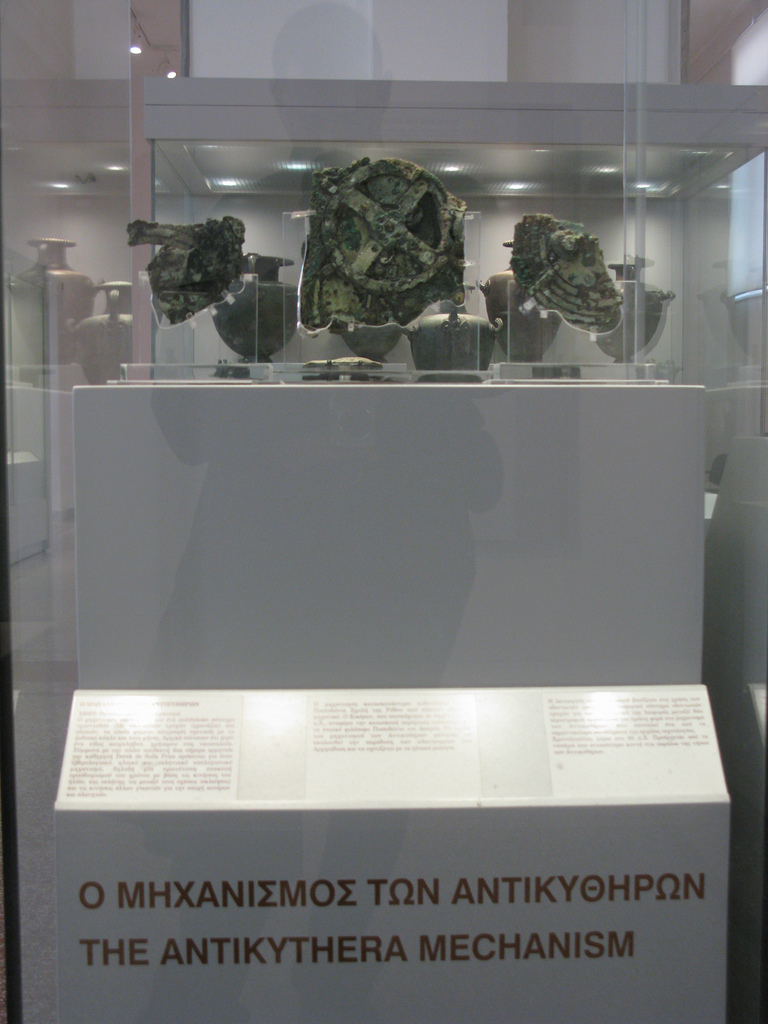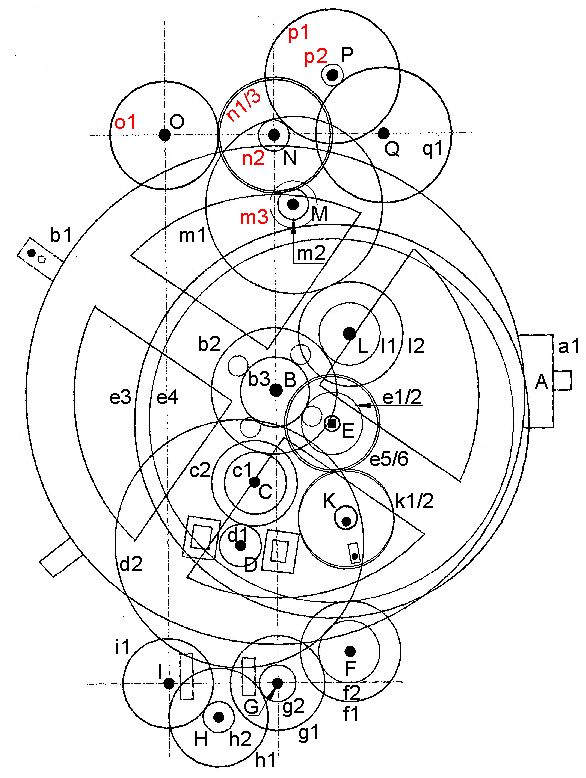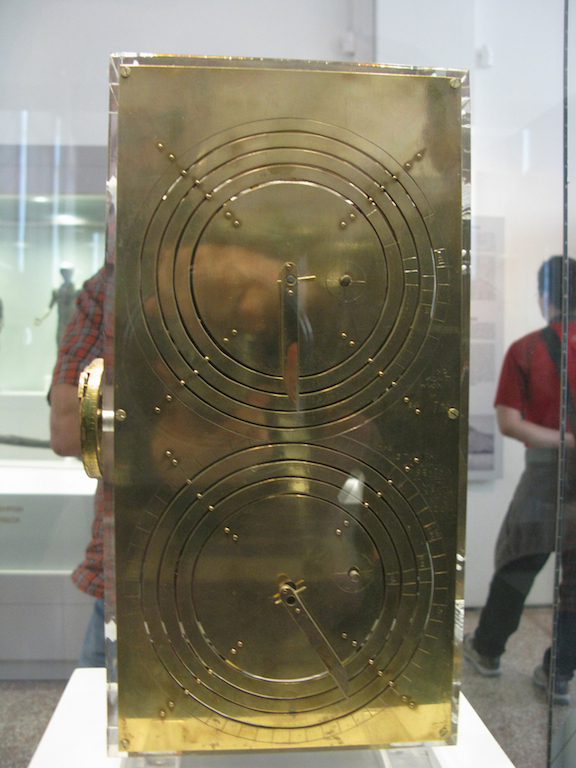86 The Antikythera Mechanism
By Murray Maloney, 2 March 2014.
Overview. In 1900, a strange looking mechanical device was recovered from a shipwreck off of the island of Antikythera, Greece. Only in the 1970s was it determined that the device was an ancient mechanical computer that performed astronomical calculations; it had a manual crank control with a rate of one turn per day, forward or backward in time; its user interface presented calendrical, solar, lunar, and planetary positions.1
The Antikythera Mechanism persists through time as a collection of artifacts and a model of intellectual achievement. Thought to have been constructed by Archimedes at Syracuse or by Posidonius at Rhodes, the mechanism was recovered from a ship wreck near the Greek island of Antikythera in 1900-1. The significance of the find only began to become apparent in the 1970s when researchers applied modern scanning technology.2
What is being organized? The Antikythera Mechanism was an arrangement of resource descriptions that represented a classical Alexandrian sol-lunar calendar, complete with an almanac of the positions of the sun, moon, known planets, and specific stars over time. The resource descriptions are represented simply by the measurements of the gears, and the corresponding information that is displayed on the front and rear panels, based on the position of those gears. These resource descriptions accounted for the range of known astronomical phenomena at the time.3
The organization of the mechanism consists of a main solar gear connected to a hand crank and a collection of gear trains that ultimately control the rotation of pointers indicating the calendar, lunar position and phases, the position of the sun and of all the known planets, and the nearest eclipse. The mechanism was housed in a wood frame box with bronze panels whose physicality was obviously intrinsic to the use of the device; the panels the back door was inscribed with what seems to be a user’s guide.
The Antikythera Mechanism calculated the position of the moon by employing five gear trains to take into account the Saros, Metonic, Callipic, and Exeligmos cycles. Thus, it was able to predict the dates of solar and lunar eclipses.
Today, the Antikythera is a collection of the eighty-two fragments that have been recovered from the ship wreck and sea bed, twenty three of which are evidently inscribed. The fragments have been dated to about 70 BCE based on the coincident presence of some coins from Pergamum and Ephesus that were recovered in the 1970s.
Why is it being organized? From a purely pragmatic perspective, the Antikythera Mechanism was a relatively portable computational device. that would have been used to accurately reckon a very specific calendar system, and to predict the cycles of days, months, years, and saro, as well as lunations, eclipses, and Olympic games. It would be an invaluable tool for astronomers, mathematicians, civil engineers, and cartographers of the time.
From a philosophical perspective, the Antikythera Mechanism was built to prove that it could be done. It represents a fulfillment of Aristotelian thought. Through the ages, the lure of scientific answers to the mathematical riddles presented among the patterns in the heavens has challenged our burgeoning intellects. The Antikythera Mechanism realized then-modern thinking on mathematics, engineering, astronomy and calendrical calculation in a portable mechanical computational device.4
How much is it being organized? Some of the major fragments are on display at the National Archaeological Museum of Athens; the others are stored.
The Antikythera Mechanism is reported to have had about thirty gears within a frame whose size was less than the volume of a large book. The level of miniaturization and the precision of fabrication was not thereafter seen until the next millennium. The engineering and machining would have required trial models, accurate plans, and custom tooling. There have been various modern attempts to re-create the Antikythera Mechanism, or at least to re-create the model it seems to have manifested.5
When is it being organized? The person who operates the mechanism turns a hand-operated crank to establish a date, or contra-wise confirms the current date by taking sightings and comparing with the dial settings. The front face offers a solar-lunar calendar dial, a tropical zodiac dial, and an almanac dial with rising and setting times of various stars. The rear panel offers dials representing the five lunar cycles.
The organization of the engineering data required to build, operate, and maintain the Antikythera Mechanism is staggering to imagine, yet it pales in comparison to the organization required to collect and archive astronomical sightings on clay tablets for hundreds of years.6 (See the sidebar, A Cuneiform Document at the Pergamon.)
The organization of the fragments of the Antikythera Mechanism is in the hands of the Bronze Collection of the National Archeological Museum in Athens.
How or by whom is it being organized? Ancient Chaldean, Greek, and Roman astronomers and engineers; modern divers, marine archaeologists, curators and researchers. In 1978, Jacques Cousteau led an expedition to the sea bed and returned some historical artifacts, that, while unrelated to the Antikythera Mechanism itself, provide additional historical context and may help date the discovery.
The Antikythera Mechanism Research Project is a collaboration of academic, industrial, and scientific researchers, who are applying some of the world’s most advanced technology to study the capabilities and applications of the Antikythera Mechanism, as well as its historical context and significance.
Other considerations. From the perspective of one ship’s unlucky captain and crew, the Antikythera Mechanism was likely just a piece of cargo, although it may have accompanied an equally unlucky passenger carrying the world’s first computer to Caesar’s court in Rome. It remains unknown how or why the device was aboard the ship or what fate befell it, but that is a story for researchers and historians to uncover in the fulness of time.
Notes: The following notes relate to this case study.
-
PBS aired Ancient Computer on April 3, 2013. The BBC aired Ancient Moon ‘computer’ revisited
-
The Antikythera Mechanism Research Project recently published The Inscriptions of the Antikythera Mechanism. 2016. Y. Bitsakis, M.G.Edmunds, A. Jones, et alia Almagest 7-1, May 2016
-
Cicero wrote about a similar device, created by Archimedes, in M. Tvlli Ciceronis de Republica Liber Primvs
Gears from the Greeks. The Antikythera Mechanism: A Calendar Computer from ca. 80 B. C. Derek de Solla Price Transactions of the American Philosophical Society New Series, Vol. 64, No. 7 (1974), pp. 1-70
-
Aristotle’s work on the subject On the Heavens (c 350 BCE) avers to the mathematical symmetry and perfection in the travels of the spheres, envisioning cycles and epicycles in motion.
In 343 BCE, Aristotle was head of the Macedonian Academy, where he tutored Alexander and his future general, Soter Ptolemy. Following Alexander‘s conquest of Babylon in 331 BCE, he ordered Kallisthenes to organize the translation of all historical astronomical observations, initiating the transfer of the world’s greatest collection of astronomical observations, dating back to 747 BCE. Within a year, Callippus had developed a new calendar, designating the summer solstice of 330 BCE as an epoch for astronomers and calendrical calculation. The Callipic cycle of 76 years less a day, equates to 27,759 days, and 940 lunations, is represented in the gearing of the mechanism.
Ptolemy established his capital at Alexandria and founded a museum, spawning the need for a library, in the Platonic style. His successors, through to Cleopatra, added to the papyrus rolls. Mathematicians, astronomers, mechanical engineers, scientists; the most famous thinkers of the ancient world studied in the halls of the Library at Alexandria. Notable to us in this context are Euclid, Archimedes, Eratosthenes, Hipparchus, Aristarchus, and Posidonius.
According to Pliny, the calendar reform of Julius Caesar, was assisted by Cleopatra‘s astronomer, Sosigenes, of Alexandria, who “brought the separate years back into conformity with the course of the sun.”
-
In 2010, Andrew Carol built a Lego model of the Antikythera Mechanism on a dare. John Pavlus wrote and directed a short film, Behind the Scenes: Lego Antikythera Mechanism.
Hublot, the Swiss maker of luxury time pieces, created a special edition Antikythera Watch. Hublot is also sponsoring ongoing research. See Return to Antikythera: A project of the Hellenic Ministry of Culture and Sports with support from the Woods Hole Oceanographic Institution
A simulation of the Antikythera Mechanism is available as an open source application on Github.
The Antikythera Mechanism Research Project maintains a list of Solid Models of the Antikythera Mechanism.
-
In his Almagest, Claudius Ptolemy marks the beginning of an epoch in recorded time, 1 Thoth 1 Nabonassar, with the coincident occurrence of a solar eclipse and the ascension of the Chaldean, King. Nabonassar in 747 BCE. (See the Almagest Ephemeris.) Nabonassar’s calendar reform began a period of seven hundred years of meticulous record keeping, indexing, summarizing, and studying. The scientific study of astronomy based upon recorded observation is thought to have begun with Nabonassar. When we talk about the discipline of organizing, we can tip our hats to Nabonassar.
John M. Steele (2000). Observations and Predictions of Eclipse Times by Early Astronomers. Kluwer Academic Publications. pp. 43–45.
The British Museum stores the “Babylonian astronomical diaries,” a highly systematized collection of ancient cuneiform texts that record periodic astronomical events, commodity prices and weather conditions over a period extending from 652 BCE to the 1st century BCE.
Aaboe, Asger. The culture of Babylonia: Babylonian mathematics, astrology, and astronomy. The Assyrian and Babylonian Empires and other States of the Near East, from the Eighth to the Sixth Centuries B.C.E Eds. John Boardman, I. E. S. Edwards, N. G. L. Hammond, E. Sollberger and C. B. F. Walker. Cambridge University Press, (1991)
Related Readings. See “Resources over Time”




